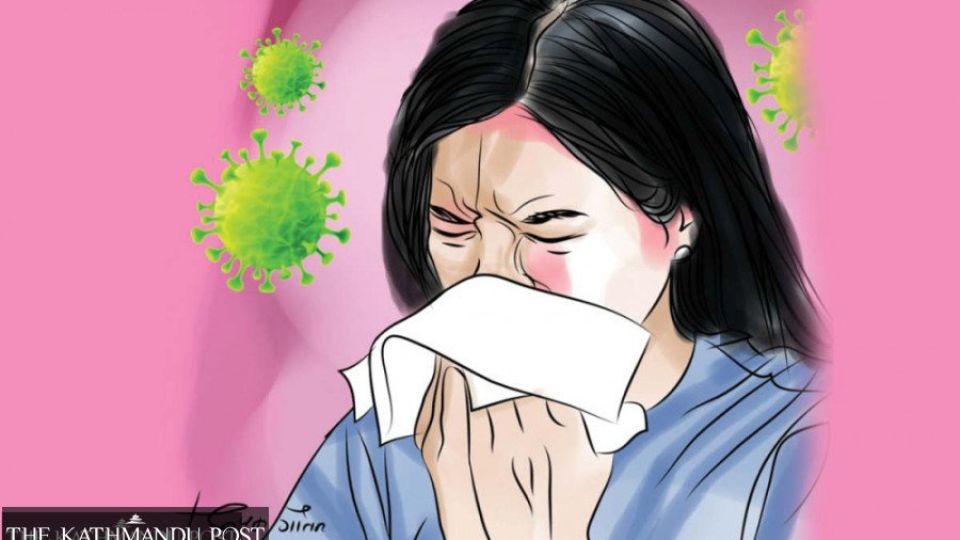September 19, 2024
KATHMANDU – Along with dengue infection, major hospitals in the Kathmandu Valley are seeing a significant surge in cases of viral fever, flu, typhoid, and seasonal influenza in recent days.
Doctors attending to the patients said that the number of fever cases has risen compared to previous months, with some patients even developing pneumonia and requiring inpatient care due to worsening health.
“Around 50 percent of the patients who come to the outpatient department at our hospital are fever cases,” said Dr Rita Hamal, a consultant paediatrician at the Chabahil-based Om Hospital and Research Centre. “Some children have also been diagnosed with pneumonia and have been admitted at the hospital for inpatient care.”
Experts say the rise in fever and cold before weather transitions is concerning and that the spread of the virus could be behind the surge in infection rates.
They say the influenza virus causes respiratory complications, which affect the lungs. The virus spreads quickly in communities. These diseases can cause fever, cough, body aches, occasional vomiting, diarrhoea, and pneumonia.
Doctors say that while the number of new cases of fever and flu has risen significantly, the exact cause of the surge still remains unclear. Many patients do not opt for various diagnostic tests, and health workers also provide symptomatic care first.
“There is no specific care for viral infections, including dengue,” said Hamal. “We provide symptomatic care only. So we do not know the actual cause of the ailments.”
Doctors recommend multiple tests only for patients with serious health conditions. They say that early diagnosis is crucial for preventing infection, and patients recover quickly if treated in time. However, according to experts, the severity of the disease and the number of deaths increase if seasonal influenza cases are not diagnosed promptly.
“We don’t know the actual cause of the surge in fever, flu, and other ailments,” said Dr Sumit Agrawal, spokesperson at the Kanti Children Hospital. “Almost all hospital beds have been occupied by ailing patients, and the number of fever cases has risen significantly recently.”
The hospital, which also serves as the national referral centre for ailing children, said that over 1,200 children seek care daily, and 30 to 40 percent of them are fever and flu cases.
Doctors at Sukraraj Tropical and Infectious Disease Hospital and Patan Hospital also said that the number of fever and flu cases has risen significantly of late.
“Along with dengue cases, the number of people suffering from viral fever, flu, typhoid and other infections has increased at our hospital as well,” said Dr Yuba Nidhi Basaula, director at the Sukraraj Tropical and Infectious Disease Hospital in Teku, Kathmandu. “Most of the beds in our hospital have been occupied. The number of dengue infection cases has also surged lately.”
Doctors at Patan Hospital said that in addition to fever cases, patients with diarrhoeal infections and other water-borne diseases are also seeking care. They expect more cases in the coming days, as fever and flu cases usually spike during weather transitions.
Even though fever and flu cases are rising significantly, authorities remain unaware of the exact cause of the surge in infection rates.
“When the cause of ailments is not ascertained, it becomes difficult to provide effective care,” said Dr Sher Bahadur Pun, chief of the Clinical Research Unit at Sukraraj Hospital. “The number of people infected with influenza could be several times higher than those seeking care at hospitals, as many people suffering from influenza-like illness do not seek treatment unless they become serious.”
A recent report by the Nepal Statistics Office also shows that cold and fever remain a significant concern, with an increase from 43.7 percent in 1995/96 to 51. 5 percent in 2022/23.
Doctors say more people get infected with viruses during seasonal changes, as most viruses—adenovirus, rhinovirus, influenza virus, and even coronavirus—become active during these times, particularly in winter.
However, they say this does not mean respiratory viruses do not spread at other times. People are continuously infected with respiratory viruses in other seasons as well, and those with weak immunity could become more severely affected by infections.
Doctors urge everyone to take precautions against these risks and ask authorities to step up surveillance to determine the real causes of influenza-like illnesses.


